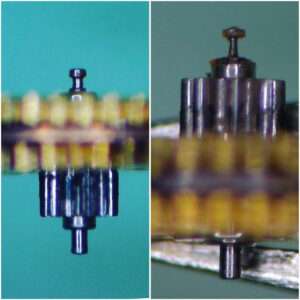We see many different types of watch come through our workshop. From quartz watches powered by batteries, through to automatic mechanical watches, we service and repair a huge range of timepieces, both modern and vintage. Recently, we’ve seen quite a few automatic watches, all of which share a fault – a heavily worn reversing wheel. In this blog post we’ll discuss the automatic winding mechanism found in many modern watches and why it experiences such wear.
The automatic winding mechanism deals with keeping the watch wound up as you move around. It consists of the rotor (or oscillating weight as it’s also known) and a series of different wheels, sitting between two bridges. As you move around, the rotor always wants to be towards the lowest point of the watch due to gravity. For example if you’re holding your automatic watch with the crown pointed in a downward direction, the rotor will be hanging down in the same way. The rotor is weighted on its outer section to encourage its motion.
As the rotor moves, a series of wheels transmit the force through to the rachet wheel, which thus winds the mainspring. The construction of the automatic system can vary from watch to watch, though the majority of modern Swiss watches use a similar design which features bi-directional winding – i.e. The rotor winds up the watch regardless of the direction it is turning. In order to allow for this bi-directional winding, a wheel called a reverser must be used.

We won’t go into the technicality of how a reverser works, though suffice to say they are a fantastically clever piece of engineering. As you can imagine, if a watch is worn on a regular basis, the automatic winding mechanism is moving all the time. It’s been said that a reverser changes direction of movement between 106 and 107 times every year. These are vital components to ensure your automatic watch continues to wind, so they need to remain in excellent condition.
As you can see from the images, these reversers are in quite the opposite – a terrible state. This is what can happen if a watch is not kept regularly serviced. The pivots have massively reduced in diameter, simply due to being thoroughly worn out. A reduction in diameter of only 10% equates to a strength reduction of approximately 1/3, so you can imagine how weak the pivots must be in these examples. The automatic winding mechanism was not functioning properly in these watches, and it’s clear to see one of the reasons why!
Like anything with moving parts, a mechanical watch needs periodic servicing in order to allow it to continue working properly for years to come. Even if you’ve had a watch for many years and it has never seen a watchmaker but it’s still ticking, this does not mean everything is fine and it does not require any attention. The longer these watches are left, the more likely it is we find additional worn parts. We advise our customers to have their watches serviced every 3-5 years, depending on the model. There are of course some exceptions, though this is a general rule.
When you have a quality timepiece from the likes of Rolex, Breitling, Omega or Tag Heuer, it makes sense to look after it. By ensuring your watch is kept regularly serviced it will continue to provide you with years and years of reliable service.
Do you have a watch in need of servicing? Contact us to see how we can help. We offer a repairs service both locally via our shops in Lewes and Uckfield, as well as nationally via our fully insured secure postal repairs service. We are experts in the repair of watches and have the skills to take on a huge variety of repairs. We are business partners of the British Horological Institute and we hold a Platinum Trusted Service award from Feefo – testament to the consistant, excellent reviews we receive from our clients.
Yours sincerely
David Clark PJDip PJGemDip CertGA
Managing Director
